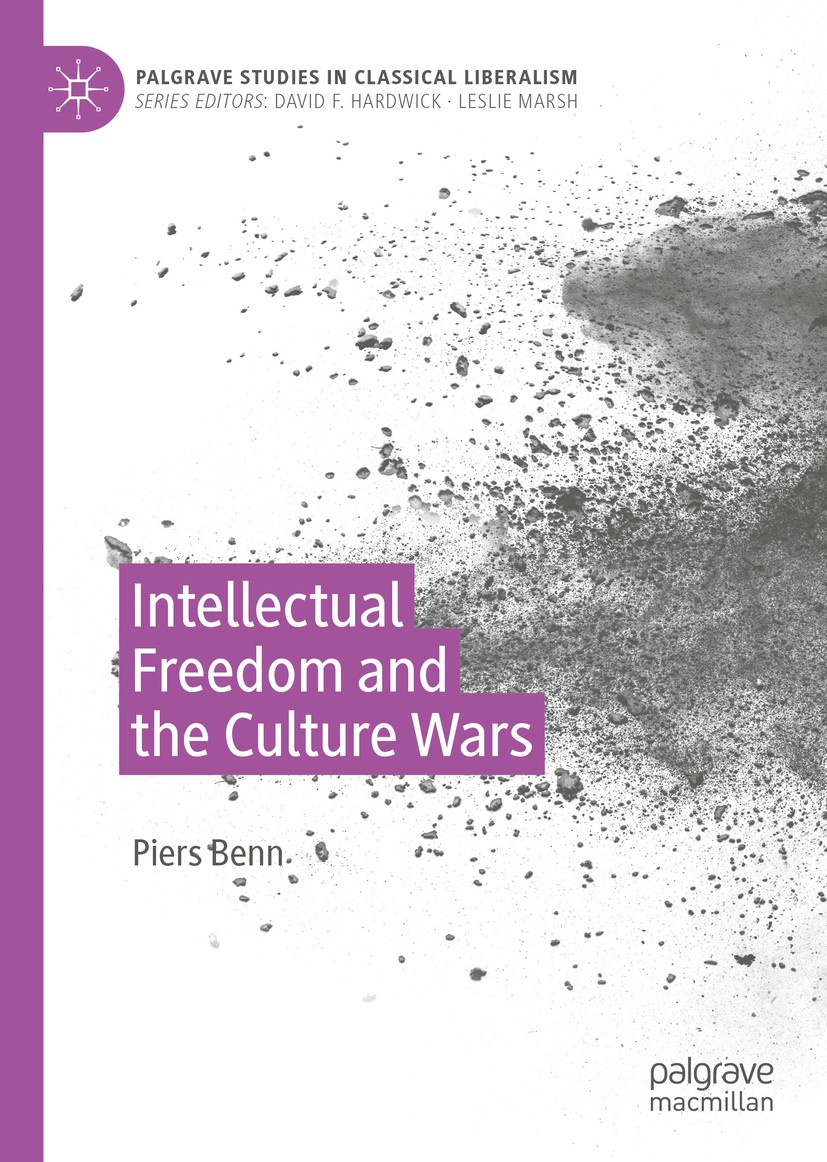Books
Intellectual Freedom and the Culture Wars—A Review
Most instructors on campus who revealed their political views also showed themselves to be a part of the Left

A review of Intellectual Freedom and the Culture Wars by Piers Benn. Palgrave MacMillan, 168 pages (October 2020)
I attended a notably liberal state university in the early 2000s. Most politically-minded students regarded themselves as either conventionally liberal or part of an amorphous Left which was focused primarily on cultural issues. I counted myself peripherally among the campus Left and participated occasionally in political activism—attending protests against the policies of the World Trade Organization and against American military adventures overseas (views which were then seen by enlightened opinion as left wing but are now, apparently, the domain of isolationist reactionaries).
Most instructors on campus who revealed their political views also showed themselves to be a part of the Left. However, there were several popular conservative professors, a vibrant sect of College Republicans consisting mostly of garden-variety neocons, plenty of libertarians, and a couple of paleoconservative Buchanan brigaders. I sparred regularly with these people in class discussions, and regarded several of them as my friends. This was not especially uncommon. The kids who were genuinely invested in politics were relatively small in number and formed a social circle built around their common interests, not their differences over policy. Moreover, plenty of conservative students worked closely with liberal professors and vice versa. I recall discussions in my upper-level history and political science courses as being uniformly a pleasure, even as my fellow wonks and I debated the most contentious topics of the present and the past.
Despite the overwhelmingly leftward sensibilities of the professoriate, most of my instructors betrayed no explicit political ideology. They presented themselves as analysts, as teachers, and as scholars but never as activists. I’ve tried to adopt this approach in my own teaching and I’m never worse as an instructor than when I try to inject my own often contradictory views into lectures or seminars.
My school had adopted standard 1990s-style hate speech codes but nobody ever talked about them, let alone tried to enforce them. I never heard anyone talk about preventing students of any political persuasion from expressing their opinions or heard any serious talk about disinviting a potentially controversial speaker from making a scheduled speaking engagement. When conservative speakers appeared on campus, such as Dinesh D’Souza or Bill Kristol, there were protests, typically organized by the Unitarian Church down the hill from campus or a local chapter of the International Socialist Organization which seemed more interested in selling $1 copies of the Socialist Worker than fomenting revolution.
Certainly, there were tense moments at such events—Q&As occasionally turned into single-speaker diatribes, there were catcalls back and forth between the campus’s left- and right-wing organizations, and the occasional jerk in the balcony might try to shout down the evening’s invited speaker. The most acrimonious political moments on campus during my tenure both involved liberal speakers. During the 2004 presidential campaign, large numbers of protesters tried to shut down an appearance by “spoiler” Green Party presidential candidate Ralph Nader. That same year, Richard Dawkins spoke on campus and drew a substantial and often disruptive group of pro-life protesters who interrupted the event on a number of occasions.

Nevertheless, the idea that anyone on campus of any political persuasion would try to prevent their political opponents from expressing their opinions or want them to be punished for it would never have occurred to me. And it still wouldn’t—my alma mater, the University of Vermont, remains strongly committed to free speech. But as I’ve traveled the country, I’ve found that this kind of open-mindedness has dissipated on many campuses, particularly over the past decade and long before performative opposition to Trump became a fixture of campus life. Like Camille Paglia, I attribute this shift on campus (through which I clearly sleepwalked) in large part to the increasing power of careerist university administrators. Higher education administrators who have genuflected, sometimes earnestly but often cynically, before the cause of the moment have a fantastic track record of bolstering their CVs and moving on up the bureaucratic food chain.
I date my awareness of the current round of theatrical assaults on free speech on college campuses to October 2012. Or possibly October 2013. Or maybe 2014. I can’t remember which. Whenever it was, this was several years before the 2016 presidential campaign. I remember visiting a college that hardly struck me as a hotbed of political correctness. They were, to my surprise, in the midst of a month-long campaign of constructing a wall of banned words. The authors of this campaign were in no way making an irreverent or tongue-in-cheek gesture, nor was the wall intended purely as politically symbolic. The people building it legitimately wanted to prevent others from using a thesaurus’s worth of vocabulary. Etched into the wall were not only obvious examples of invective but also dozens of entirely benign adjectives.
The construction and public presentation of this temporary wall (which I have been told continues to make regular appearances on campus) was overseen not only by a handful of earnest undergraduates but also on-duty campus life administrators. When I asked one of the campus life employees assigned to the wall what was objectionable about such words as “overbearing,” “cocky,” and “unprofessional,” he tried to discern who I was and what my role was at the institution. After explaining that I was there for the day to look at some microfiche and hopefully dine on a Frosty, Biggie Fries, and a chilli with cheese at the soon-to-be closed on-campus Wendy’s, he directed me to a campus life website as a starting point for my education on the subject. He also tut-tutted at my support for factory farming. Ever since then, I have seen numerous ridiculous displays of this kind at colleges across the country, just as the phenomenon of shutting down or disinviting potentially controversial speakers became de rigueur at America’s most respected institutions.

Piers Benn’s fantastic new book, Intellectual Freedom and the Culture Wars—the latest contribution to Palgrave’s esteemed “Studies in Classical Liberalism” series—is the finest scholarly genealogy in print of how discussions like the one I had in front of the wall of banned words became commonplace on college campuses. Although Benn focuses primarily on examples within the British Commonwealth, the examples he brings to bear could easily have happened at American universities. Benn, a Philosophy PhD and professor in the United Kingdom, writes with a rare combination of clarity and intellectual distinction. He owes an obvious and explicitly stated intellectual debt to John Stuart Mill, whom he cites as the father of the notion of free inquiry he defends in this volume.
Like Mill, Benn contends that free inquiry is essential to scholarly study. He champions the Socratic method as the best means of challenging and refining arguments. If a professor or researcher is not open to the possibility that their questions may produce taboo answers, they are hindering the pursuit of potentially useful knowledge. The author juxtaposes Mill’s imperative for free inquiry with contemporary notions of taking offense, a social and cultural response which he notes has been accelerated by the rise of decidedly vicious and often anonymous online attacks between persons who will almost certainly never meet face-to-face. He makes generous allowances for the rather obvious (though treated-as-profound) idea articulated by the doyens of “equity” that power differentials between actors tend to allow the powerful to reinforce existing hierarchies of influence.
After stating the case for censorship of potentially offensive ideas or speakers, Benn takes the idea to task through the use of several real world examples. He examines the 2015 case of celebrated feminist Germaine Greer being disinvited from a speaking engagement at the University of Cardiff for holding “trans-exclusionary views.” He also looks at the disinvitation of Iranian dissident Maryam Namazie from a scheduled lecture at Warwick University for holding views the Student Union deemed anti-Islamic. Again invoking Mill, Benn makes a distinction between ideas that cause offense and ideas that cause harm, and argues that as the consensus threshold for harm has declined, the capacity of individuals to engage in free inquiry has also diminished. He cautions strongly against the contemporary impulse, which has become especially pronounced at universities, to pre-empt offense by preventing potentially controversial ideas from being aired on campus or “deplatforming” suspected vessels of those ideas.
The author regards the atmosphere that this academic culture of disinvitation has engendered as leading to a kind of self-policing that imperils the pursuit of truth. An academic culture that was largely conducive to free inquiry has been replaced by one detached from reality—an ivory tower that juxtaposes fashionable moral relativism with a sentimentalization of all things that seem to transgress traditional social relations and their apparent hierarchies.
In “Power, Privilege, and Identity,” the book’s most robust chapter, Benn builds a strong case against the concepts of “privilege” or “identity politics” serving as the prevailing architecture for inquiry. Instead, he contends that the liberal intellectual tradition has a long track record of producing better responses to questions of public controversy. Benn concedes on numerous occasions that the canon and conceptual frameworks in which he is deeply invested are rooted in the thinking of historically dominant groups, but he cautions against throwing the baby out with the bathwater. The classical liberal scholarly tradition encourages logical give-and-take, argument-and-counter-argument, compromise, and loyal opposition rather than social division and what he rightly terms the “Manichean mentality” which characterizes much of contemporary political debate on the Left and Right. He is concerned with the calcifying intellectual conformity that has emerged at so many universities, which discourages the interrogation of ideas—a pursuit which Benn champions with admirable earnestness.
In the end, Benn’s book is a call for people to stop hounding their political opponents, particularly within the context of universities—in his own words, “encouraging people to think of themselves as partaking of a shared humanity, with a shared capacity for virtue and reflection…” To my recollection, this was not all that uncommon at universities, even in the relatively recent past. Count me as among the optimistic that this sensibility will soon come back into favor. Politics never remains fashionable on campus for all that long. It will become the domain of the campus wonks once again as soon as something new fills the cultural void.






